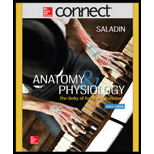
Concept explainers
The clear, structureless gel in a cell is its
- a. nucleoplasm.
- b. protoplasm.
- c. cytoplasm.
- d. neoplasm.
- e. cytosol.
Introduction:
All living organisms are made up of cells and its products. Cells are regarded as the simplest unit (structural and functional) of life. Cellular membrane, nucleus, and cytoplasm are the three major components of a cell. Cellular membrane, which surrounds the entire cell, is composed of phospholipids and proteins. The nucleus is bound by a nuclear membrane, and it possesses the genetic material of the cell. The cytoplasm consists of organelles, cytoskeleton (filaments and tubules), and inclusion bodies.
Answer to Problem 1TYR
Correct answer:
The organelles, cytoskeleton (filaments and tubules), and inclusion bodies present in the cell are dispersed in a clear, structure-less gel known as cytosol. Therefore, option e is correct.
Explanation of Solution
Justify reasons for the correct statement:
Cytosol (cell substance) or intracellular fluid (ICF) is a clear, gel-like substances that is mostly made up of water, water-soluble molecules, and dissolved ions.
Option (e) is given as “cytosol”.
Cytosol is a structure-less, gel-like substance, which fills the cytoplasm of the cell.
Hence, option (e) is correct.
Justify reasons for the incorrect statements:
Option (a) is given as “nucleoplasm”.
Nucleoplasm is a structure-less, gel-like material that fills the nucleus. Hence, it is a wrong answer.
Option (b) is given as “protoplasm”.
Protoplasm denotes all living materials that are present in the cell enclosed by the cellular membrane (inside and outside the nucleus). The protoplasm inside and outside the nucleus is known as nucleoplasm and cytoplasm, respectively. Hence, it is a wrong answer.
Option (c) is given as “cytoplasm”.
The protoplasm that is enclosed within the cellular membrane and outside the nucleus of the cell is called as cytoplasm. Cytoplasm consists of organelles, cytoskeleton (filaments and tubules), and inclusion bodies. Hence, it is a wrong answer.
Option (d) is given as “neoplasm”.
The abnormal tissue growth resulting from rapid and uncoordinated cell division is referred to as neoplasm. Hence, it is a wrong answer.
Hence, options (a), (b), (c), and (d) are incorrect.
The clear, structure-less gel-like substance present in the cell is called as the cytosol.
Want to see more full solutions like this?
Chapter 3 Solutions
CONNECT ACCESS CARD FOR ANATOMY AND PHYSIOLOGY
Additional Science Textbook Solutions
Laboratory Manual For Human Anatomy & Physiology
Genetics: From Genes to Genomes
Organic Chemistry (8th Edition)
EBK INTRODUCTION TO CHEMISTRY
Campbell Essential Biology (7th Edition)
- Identify the indicated cavity (Fucus). a. antheridia b. conceptacel c. receptacle d. oogonium e. none of thesearrow_forwardIdentify the indicated structure (Saprolegnia). a. antheridium O b. oospore c.sperm d. auxospore e. tetraspore Of. zygosporearrow_forwardUsing information from the primary literature (several references have been provided as a starting point below) please answer the following question: Based on your review of the literature on rewilding, what are the major scientific pros and cons for rewilding? Please note that the focus of this assignment are the (biological) scientific issues associated with rewilding. As will be discussed in class, there are a number of non-scientific issues involved or implicated in rewilding, all ultimately affecting the public acceptability of rewilding. Although these issues are important – indeed, critical – in this assignment you should focus on the biological science issues and questions. Details: You must enumerate at least two pros and at least two cons. Your answer should be no more than 500 well-chosen words, excluding references. Think carefully about how best to organize and structure your answer. Aim for high information density: say a lot, but say it succinctly. Recall Nietzche’s…arrow_forward
- Using information from the primary literature (several references have been provided as a starting point below) please answer the following question: Based on your review of the literature on rewilding, what are the major scientific pros and cons for rewilding? Please note that the focus of this assignment are the (biological) scientific issues associated with rewilding. As will be discussed in class, there are a number of non-scientific issues involved or implicated in rewilding, all ultimately affecting the public acceptability of rewilding. Although these issues are important – indeed, critical – in this assignment you should focus on the biological science issues and questions. Details: You must enumerate at least two pros and at least two cons. Your answer should be no more than 500 well-chosen words, excluding references. Think carefully about how best to organize and structure your answer. Aim for high information density: say a lot, but say it succinctly. Recall Nietzche’s…arrow_forwardNow draw a rough sketch of what the control data might look like if in addition to the specific binding, there was also a considerable amount of nonspecific binding (again using a normal dose/response curve) (do % total bound ligand vs concentration)arrow_forwardWhat are functions of cuboidal cells in the kidney? Select all that apply. Concentration of gases Dilution of chemicals Secretion of molecules Nutrition to tissues Support of tissues Absorption of moleculesarrow_forward
- question1 In plants, epithelial tissue is only found as the outermost cell layer and acts as a barrier. In humans, epithelial tissue is found inside the body as well as on the surface. What function(s) does/do epithelial tissue carry out in humans? Select all that apply. Waste storage Filtration Oxygen transport Protection Diffusion Osmosis Absorptionarrow_forwardWhat words best describes this organism? a. Unicellular/nonmotile Ob. unicellular/motile c. colonial/nonmotile d. colonial/motile e. multicelluar O f. siphonous g. none of thesearrow_forwardIdentify the phylum or class. a. Euglenophyta b. Dinoflagellata c. Bacillariophyceae d. Oomycetes e. Phaeophyceae O f. Myxomycota g. Xanthophyceae ○ h. Chrysophyceae i. Dictyosteliomycota O j. Rhodophyta Ok. Chlorophyceaens I. Charophyceaensarrow_forward
 Concepts of BiologyBiologyISBN:9781938168116Author:Samantha Fowler, Rebecca Roush, James WisePublisher:OpenStax College
Concepts of BiologyBiologyISBN:9781938168116Author:Samantha Fowler, Rebecca Roush, James WisePublisher:OpenStax College Human Physiology: From Cells to Systems (MindTap ...BiologyISBN:9781285866932Author:Lauralee SherwoodPublisher:Cengage Learning
Human Physiology: From Cells to Systems (MindTap ...BiologyISBN:9781285866932Author:Lauralee SherwoodPublisher:Cengage Learning Human Biology (MindTap Course List)BiologyISBN:9781305112100Author:Cecie Starr, Beverly McMillanPublisher:Cengage Learning
Human Biology (MindTap Course List)BiologyISBN:9781305112100Author:Cecie Starr, Beverly McMillanPublisher:Cengage Learning





